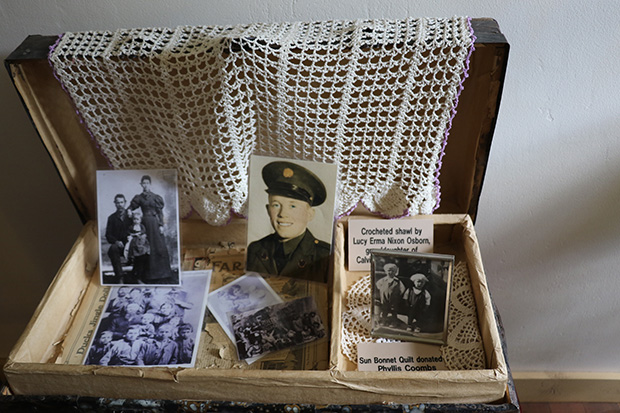Pioneer Settlement of Fruita a “Tasty” Testament to Mormon Grit and Industry
Contributed By Jason Swensen, Church News staff writer

A pear tree planted by Mormon settlers to Fruita sits in a high-walled valley in Capitol Reef National Park. Photo by Jason Swensen.
Article Highlights
- In 1880, Mormon settlers turned the arid area of Wayne County into a fruitful orchard and town.
- Visitors are welcome to tour the historic town and orchard, now part of a national park.
“Their cooperative spirit, determination, and spiritual bond were important to the survival of Fruita as an isolated settlement in a remote location.” —Historical marker
Related Links
CAPITOL REEF NATIONAL PARK, UTAH
An overlook just a few steps from the Hickman Bridge natural arch offers hikers a stunning, waiting-to-be-photographed testament to Mormon grit and ingenuity.
A rich valley orchard rests deep below and flanked by the vastness of cliff and sage that define this untamed region of Capitol Reef. It’s an oasis of fruit-laden, verdant trees that almost seems to mock its surrounding desolation.
This trailside view prompts an obvious question: How did apple, pear, apricot, and cherry trees find a home in such wilderness?
Its answer is found in the long-abandoned Mormon settlement aptly called Fruita.
A tasty surprise
Located in the northern half of Capitol Reef National Park, the Fruita Historic District is likely an inspiring (and often tasty) surprise for the hundreds of thousands of worldwide visitors who pass through the park each year.
The park’s visitor center offers a brief history of Fruita:
In 1880, Mormon settlers—answering Brigham Young’s charge to “go forth and populate the territory”—recognized opportunity in this lonesome sliver of land in what is now Utah’s Wayne County.
Yes, there were extreme arid temperatures, flash floods, and daunting high canyon walls—but there was also water for irrigation and rich soil to be farmed. The Latter-day Saints who would populate Fruita would plant the aforementioned orchards, build homes, and construct a tiny school.
Determination in adversity
Life was often hard for Fruita’s Mormons. The summers were hot and the winters could be bitter cold. Sudden rains often turned into deadly washouts. But for more than half a century, the residents of Fruita formed a determined community.
“Their cooperative spirit, determination, and spiritual bond were important to the survival of Fruita as an isolated settlement in a remote location,” notes a historical marker placed aside Fruita’s historic one-room schoolhouse.
The Amasa Pierce Orchard is found just a few steps from the schoolhouse. The Pierce family moved to what would become Fruita around 1895. Amasa Pierce served for years as the community’s presiding Church elder. His wife, Maria Ann, would organize Fruita’s first Primary.
The communal labors of the Pierces and several other LDS families would earn tiny Fruita the title “Eden of Wayne County.”
Cooperation and preservation

Nels Johnson and his family were among the first Mormons to settle what would become the community of Fruita in the late 19th century. Photo displayed at the Gifford House.

Fruita's tiny one-room schoolhouse was built by the community’s Mormon settlers over a century ago. The structure was also used for Church gatherings and social functions. Photo by Jason Swensen.
The Mormons weren’t the first to call the Fremont River Valley home. Centuries earlier, Fremont Indians supplemented their hunter/gatherer existence by growing corn, squash, and other crops near the river.
And like the region’s first indigenous settlers, the Mormons would not find a permanent home in this valley. Over time, the area’s stunning natural landscapes captured the attention of outdoor lovers. Calls were made to place the region under federal protection, and the National Park Service purchased land owned by the residents. Fruita’s last family, the Giffords, left the valley in 1969.
In 1971, the Capitol Reef region encompassing Fruita was officially designated as a U.S. national park.
Delicious legacy
The Mormon residents of Fruita are gone—but their legacy of community, hard work, and industry remains. A few of the remaining structures, including the restored schoolhouse and the Gifford House, attract tourists every day.
Meanwhile, the Fruita orchards—which include about 3,000 trees—are maintained by the park service. Visitors can pick and snack on orchard fruit when they come into season.
Perhaps with each juicy bite of a local apple or pear, a Fruita newcomer’s thoughts turn to the area’s remarkable Mormon past.
“For both regional neighbors and visitors throughout the world,” notes a park release, “Fruita will continue to be the ‘Eden of Wayne County.’”

The Fruita Historic District in Capitol Reef National Park welcomes hundreds of thousands of global visitors each year. Photo by Jason Swensen.

Names of early Mormon settlers are found on the “Pioneer Registry” along the canyon walls of Capitol Reef National Park. Photo by Jason Swensen.

The historic Gifford House is now used as a museum and store for visitors to the Mormon community of Fruita in Capitol Reef National Park. Photo by Jason Swensen.

A museum display inside the Gifford House tells the story of Fruita’s Mormon settlers. Photo by Jason Swensen.

An undated historical photo displayed at the Gifford House shows children gathered near an inscripted boulder near the Fruita schoolhouse. Photo by Jason Swensen.

An oasis of fruit trees can be seen below an overlook near the Hickman Bridge natural arch in Capitol Reef National Park. The orchard was planted by the Mormon settlers of Fruita. Photo by Jason Swensen.

Fruita settlers Amasa and Maria Ann Pierce cultivated their orchard near the tiny community’s schoolhouse. The Pierces each performed Church leadership roles in Fruita. Photo by Jason Swensen.
